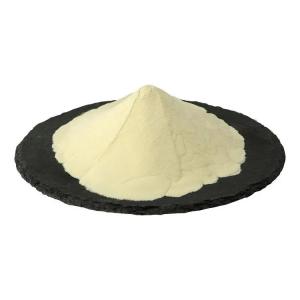Phosphatidyl serine is used in non-dairy yogurts.
Time:2025-08-01Non-dairy yogurts have gained significant traction in recent years as more consumers seek plant-based alternatives due to dietary preferences, lactose intolerance, or ethical concerns regarding animal products. With the rise in popularity of plant-based diets, manufacturers are increasingly looking for ways to improve the texture, taste, and nutritional profile of non-dairy yogurts. One such ingredient that has emerged as a key component in enhancing the quality of non-dairy yogurts is phosphatidylserine (PS), a phospholipid commonly found in plant sources, especially soy and cabbage.
In this article, we will explore how phosphatidylserine is used in non-dairy yogurts, its functional benefits, and the potential impact on the plant-based yogurt industry.
1. What is Phosphatidylserine?
Phosphatidylserine is a naturally occurring phospholipid that plays a crucial role in maintaining cellular structure and function. It is primarily found in the brain, where it contributes to cognitive functions such as memory and learning. While it is often consumed in the form of dietary supplements, phosphatidylserine can also be extracted from plant sources, making it suitable for vegan and vegetarian diets. It is commonly sourced from soy lecithin or cabbage, and it is prized for its emulsifying and stabilizing properties.
2. Phosphatidylserine in Non-Dairy Yogurts
Non-dairy yogurts are typically made from plant-based milks like almond, coconut, soy, and oat. However, creating the ideal texture and consistency in these non-dairy products can be challenging, as plant-based milks tend to have different physical properties compared to dairy milk. This is where phosphatidylserine comes in. By incorporating phosphatidylserine into non-dairy yogurt formulations, manufacturers can achieve several functional benefits.
A. Emulsifying Properties
Phosphatidylserine acts as an excellent emulsifier, helping to stabilize the fat-water matrix in non-dairy yogurt. Plant-based yogurts, especially those made from almond, coconut, or cashew milk, often struggle with the separation of liquid and solids over time. Phosphatidylserine helps prevent this separation, ensuring a uniform consistency throughout the product, much like the texture found in traditional dairy yogurts.
B. Texture and Creaminess
One of the key challenges in non-dairy yogurt production is achieving the creamy, smooth texture that dairy yogurt naturally provides. Phosphatidylserine helps improve the mouthfeel of non-dairy yogurts by enhancing the emulsification of fats, which is crucial for creaminess. This results in a richer and more satisfying texture, making the product more appealing to consumers who are accustomed to the indulgence of traditional yogurt.
C. Preventing Ice Crystallization
When producing frozen or semi-frozen non-dairy yogurt varieties, phosphatidylserine can help reduce ice crystal formation, which can lead to a gritty or grainy texture. By preventing the formation of large ice crystals, phosphatidylserine contributes to a smoother texture, even in frozen varieties, offering an experience similar to that of traditional dairy-based frozen yogurt.
3. Nutritional Benefits of Phosphatidylserine in Non-Dairy Yogurts
Phosphatidylserine is not only a functional ingredient but also has potential nutritional benefits, which can appeal to health-conscious consumers. In addition to supporting cognitive health, PS is known to help with reducing cortisol levels, which may help in stress management. By incorporating phosphatidylserine into non-dairy yogurts, manufacturers can create functional foods that align with the growing trend of health-focused eating.
Cognitive Health: Phosphatidylserine is often linked to brain health, particularly for its role in enhancing memory, mental clarity, and overall cognitive function. Adding it to non-dairy yogurts offers a unique opportunity to create functional snacks that support brain health.
Stress Reduction: Phosphatidylserine has been shown to regulate cortisol, the stress hormone, which may help consumers reduce stress levels. Non-dairy yogurt with added PS can provide a stress-relieving snack that is both delicious and nutritious.
4. Market Trends and Consumer Demand
As the demand for plant-based and functional foods continues to rise, the addition of phosphatidylserine in non-dairy yogurts presents a compelling opportunity for manufacturers to stand out in a competitive market. With consumers increasingly seeking products that provide not only taste but also added health benefits, functional ingredients like phosphatidylserine are in high demand.
Health-Conscious Consumers: Consumers are looking for products that align with their wellness goals. Non-dairy yogurts with added cognitive and stress-reducing benefits can attract this segment, offering an alternative to traditional snacks that also supports brain health.
Vegan and Lactose-Free Options: The rise of veganism and the growing number of individuals who are lactose intolerant make plant-based yogurts an attractive choice. Phosphatidylserine, derived from plant-based sources like soy and cabbage, fits perfectly into the vegan and lactose-free market.
5. Challenges and Considerations
Despite its many benefits, there are some considerations when incorporating phosphatidylserine into non-dairy yogurts:
A. Flavor Considerations
Phosphatidylserine, while generally neutral, may have a slight bitter aftertaste. Careful formulation is needed to mask or balance this taste, particularly in flavored non-dairy yogurts where taste is critical. Manufacturers may need to experiment with sweeteners or flavor enhancers to ensure the final product remains delicious.
B. Cost and Sourcing
The cost of phosphatidylserine may be higher than that of traditional emulsifiers or stabilizers, especially if it is sourced from non-GMO or sustainable suppliers. The higher cost could impact the retail price of the product, so manufacturers must weigh the benefits of adding PS against the potential cost implications.
C. Consumer Awareness and Education
As phosphatidylserine is not yet a household name in the food industry, consumer education will be crucial for products containing this ingredient. Manufacturers will need to clearly communicate the functional benefits of phosphatidylserine, especially its potential cognitive and stress-reducing effects, to appeal to health-conscious consumers.
6. Conclusion
Phosphatidylserine is a valuable addition to non-dairy yogurts, offering functional benefits that improve texture, stability, and nutritional value. By acting as an emulsifier and stabilizer, it enhances the creamy texture and consistency of plant-based yogurts, while also providing potential health benefits like cognitive support and stress reduction. As the plant-based and functional food markets continue to grow, incorporating phosphatidylserine into non-dairy yogurts could help manufacturers create products that meet both the taste preferences and health needs of modern consumers.


 CN
CN





